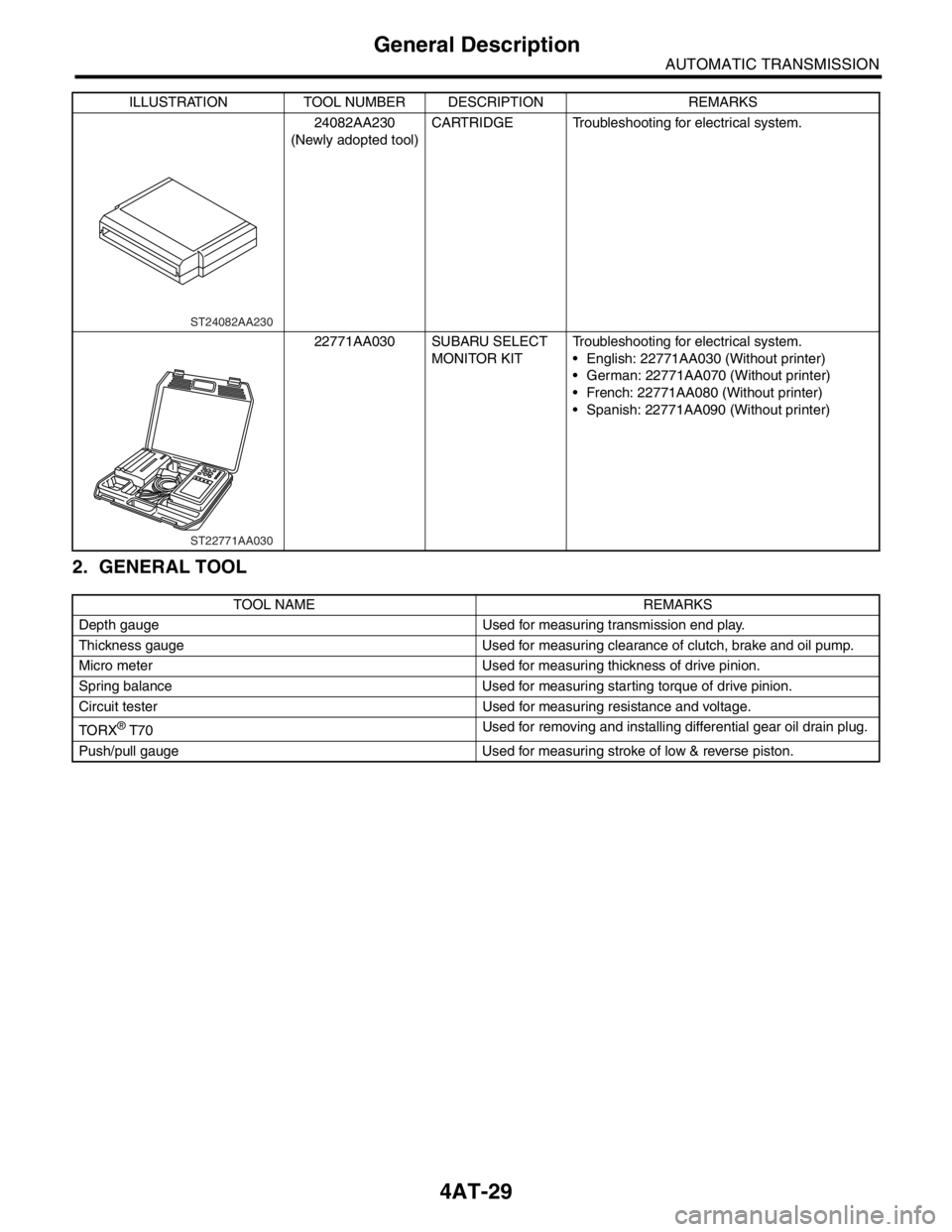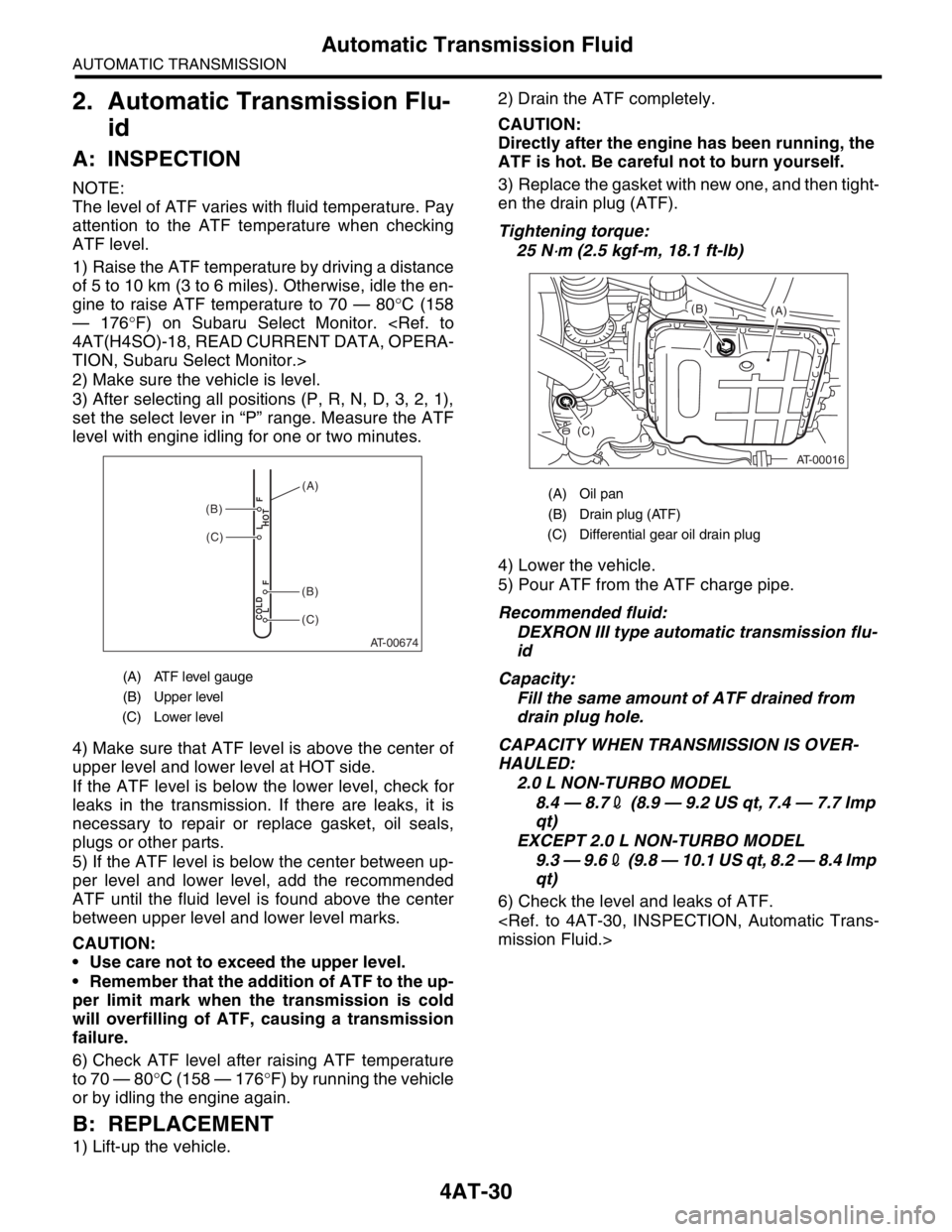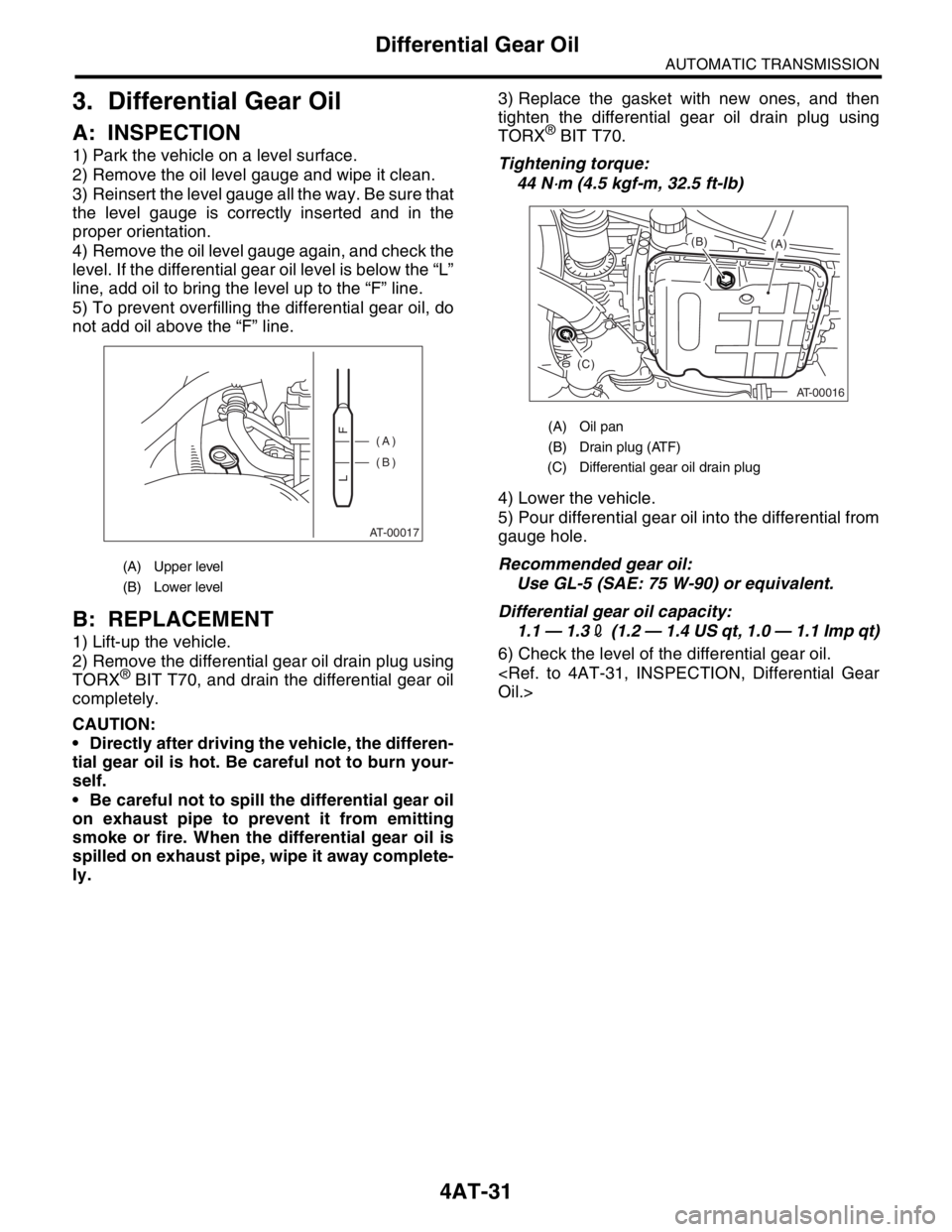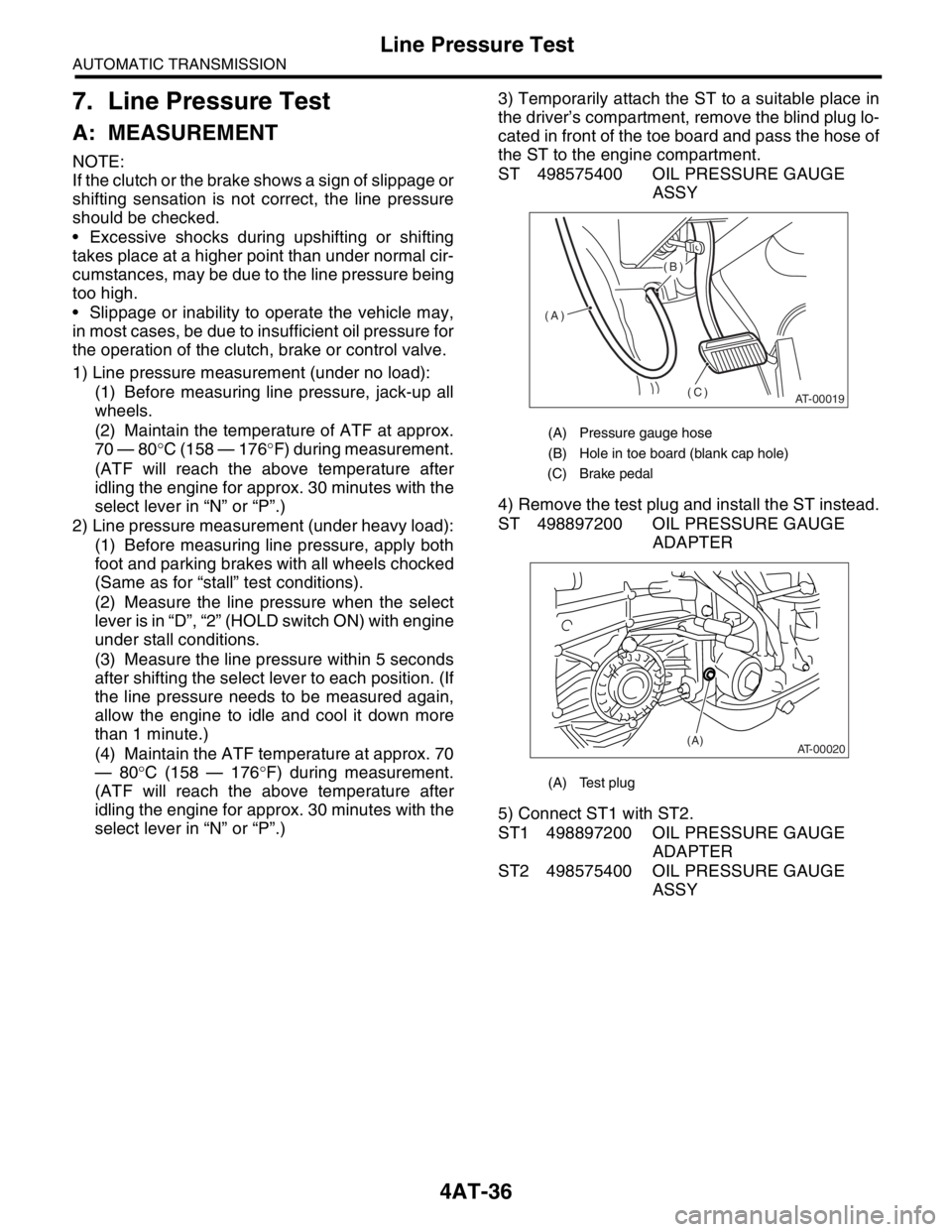SUBARU FORESTER 2004 Service Repair Manual
Manufacturer: SUBARU, Model Year: 2004, Model line: FORESTER, Model: SUBARU FORESTER 2004Pages: 2870, PDF Size: 38.67 MB
Page 2341 of 2870

4AT-29
AUTOMATIC TRANSMISSION
General Description
2. GENERAL TOOL
24082AA230
(Newly adopted tool)CARTRIDGE Troubleshooting for electrical system.
22771AA030 SUBARU SELECT
MONITOR KITTroubleshooting for electrical system.
English: 22771AA030 (Without printer)
German: 22771AA070 (Without printer)
French: 22771AA080 (Without printer)
Spanish: 22771AA090 (Without printer)
TOOL NAME REMARKS
Depth gauge Used for measuring transmission end play.
Thickness gauge Used for measuring clearance of clutch, brake and oil pump.
Micro meter Used for measuring thickness of drive pinion.
Spring balance Used for measuring starting torque of drive pinion.
Circuit tester Used for measuring resistance and voltage.
TO RX
® T70Used for removing and installing differential gear oil drain plug.
Push/pull gauge Used for measuring stroke of low & reverse piston.ILLUSTRATION TOOL NUMBER DESCRIPTION REMARKS
ST24082AA230
ST22771AA030
Page 2342 of 2870

4AT-30
AUTOMATIC TRANSMISSION
Automatic Transmission Fluid
2. Automatic Transmission Flu-
id
A: INSPECTION
NOTE:
The level of ATF varies with fluid temperature. Pay
attention to the ATF temperature when checking
ATF level.
1) Raise the ATF temperature by driving a distance
of 5 to 10 km (3 to 6 miles). Otherwise, idle the en-
gine to raise ATF temperature to 70 — 80°C (158
— 176°F) on Subaru Select Monitor.
TION, Subaru Select Monitor.>
2) Make sure the vehicle is level.
3) After selecting all positions (P, R, N, D, 3, 2, 1),
set the select lever in “P” range. Measure the ATF
level with engine idling for one or two minutes.
4) Make sure that ATF level is above the center of
upper level and lower level at HOT side.
If the ATF level is below the lower level, check for
leaks in the transmission. If there are leaks, it is
necessary to repair or replace gasket, oil seals,
plugs or other parts.
5) If the ATF level is below the center between up-
per level and lower level, add the recommended
ATF until the fluid level is found above the center
between upper level and lower level marks.
CAUTION:
Use care not to exceed the upper level.
Remember that the addition of ATF to the up-
per limit mark when the transmission is cold
will overfilling of ATF, causing a transmission
failure.
6) Check ATF level after raising ATF temperature
to 70 — 80°C (158 — 176°F) by running the vehicle
or by idling the engine again.
B: REPLACEMENT
1) Lift-up the vehicle.2) Drain the ATF completely.
CAUTION:
Directly after the engine has been running, the
ATF is hot. Be careful not to burn yourself.
3) Replace the gasket with new one, and then tight-
en the drain plug (ATF).
Tightening torque:
25 N
⋅m (2.5 kgf-m, 18.1 ft-lb)
4) Lower the vehicle.
5) Pour ATF from the ATF charge pipe.
Recommended fluid:
DEXRON III type automatic transmission flu-
id
Capacity:
Fill the same amount of ATF drained from
drain plug hole.
CAPACITY WHEN TRANSMISSION IS OVER-
HAULED:
2.0 L NON-TURBO MODEL
8.4 — 8.72 (8.9 — 9.2 US qt, 7.4 — 7.7 Imp
qt)
EXCEPT 2.0 L NON-TURBO MODEL
9.3 — 9.62 (9.8 — 10.1 US qt, 8.2 — 8.4 Imp
qt)
6) Check the level and leaks of ATF.
(A) ATF level gauge
(B) Upper level
(C) Lower level
AT-00674
COLD
LFHOT LF
(C)
(C)
(B)
(B)
(A)(A) Oil pan
(B) Drain plug (ATF)
(C) Differential gear oil drain plug
AT-00016
(A) (B)
(C)
Page 2343 of 2870

4AT-31
AUTOMATIC TRANSMISSION
Differential Gear Oil
3. Differential Gear Oil
A: INSPECTION
1) Park the vehicle on a level surface.
2) Remove the oil level gauge and wipe it clean.
3) Reinsert the level gauge all the way. Be sure that
the level gauge is correctly inserted and in the
proper orientation.
4) Remove the oil level gauge again, and check the
level. If the differential gear oil level is below the “L”
line, add oil to bring the level up to the “F” line.
5) To prevent overfilling the differential gear oil, do
not add oil above the “F” line.
B: REPLACEMENT
1) Lift-up the vehicle.
2) Remove the differential gear oil drain plug using
TORX
® BIT T70, and drain the differential gear oil
completely.
CAUTION:
Directly after driving the vehicle, the differen-
tial gear oil is hot. Be careful not to burn your-
self.
Be careful not to spill the differential gear oil
on exhaust pipe to prevent it from emitting
smoke or fire. When the differential gear oil is
spilled on exhaust pipe, wipe it away complete-
ly.3) Replace the gasket with new ones, and then
tighten the differential gear oil drain plug using
TORX
® BIT T70.
Tightening torque:
44 N
⋅m (4.5 kgf-m, 32.5 ft-lb)
4) Lower the vehicle.
5) Pour differential gear oil into the differential from
gauge hole.
Recommended gear oil:
Use GL-5 (SAE: 75 W-90) or equivalent.
Differential gear oil capacity:
1.1 — 1.32 (1.2 — 1.4 US qt, 1.0 — 1.1 Imp qt)
6) Check the level of the differential gear oil.
(A) Upper level
(B) Lower level
AT-00017
(A)
(B)
LF
(A) Oil pan
(B) Drain plug (ATF)
(C) Differential gear oil drain plug
AT-00016
(A) (B)
(C)
Page 2344 of 2870

4AT-32
AUTOMATIC TRANSMISSION
Road Test
4. Road Test
A: INSPECTION
1. GENERAL PRECAUTION
Road tests should be conducted to properly diag-
nose the condition of the automatic transmission.
NOTE:
When performing the test, do not exceed posted
speed limit.
2. D RANGE SHIFT FUNCTION
Check shifting between 1st ←→ 2nd ←→ 3rd ←→
4th while driving on normal city streets.
3. D RANGE SHIFT SHOCK
Check the shock level when shifting up during nor-
mal driving.
4. KICK-DOWN FUNCTION
Check kick-down for each gear. Also check the
kick-down shock level.
5. ENGINE BRAKE OPERATION
Check the 3rd gear engine brake when shifting
down from D ←→ 3rd range while driving in 4th
gear of D range [50 — 60 km/h (31 — 37 MPH)].
Check the 2nd gear engine brake when shifting
between 3rd ←→ 2nd range while driving in the 3rd
range of 3rd gear [40 — 50 km/h (25 — 31 MPH)].
Check the 1st gear engine brake when shifting
between 2nd ←→ 1st range while driving in the 2nd
range of 2nd gear [20 — 30 km/h (12 — 19 MPH)].
6. LOCK-UP FUNCTION
Check that rpm does not change sharply when
the axle pedal is lightly depressed when driving on
flat roads at 60 km/h (37 MPH).
Check slip lock-up with following procedure.
Subaru Select Monitor is needed for checking (EC,
EK model).
Before start checking, check that the DTC is not ex-
isted using Subaru Select Monitor. When the DTC
is existed, perform the collective action with DTC
and check that the DTC is not existed again, and
then start the checking.
1) The check performed on flat and straight road or
free roller.
NOTE:
Slip lock-up does not operate when the vehicle is
lifted up, because of not occurring surface resis-
tance.
Also checking on the free roller, check with de-
pressing foot brake lightly to make the checking
easier, because the surface resistance will be defi-
cient2) Connect the Subaru Select Monitor.
3) Check ATF temperature using Subaru Select
Monitor.
NOTE:
ATF temperature is between 50 — 100°C (122
— 212°F).
When the temperature is low, warm-up the ATF
by running the vehicle or etc.
4) Start the engine, and make the lock-up duty be
able to read on data display of Subaru Select Mon-
itor.
5) 35 — 40 Drive the vehicle at a constant speed of
35 — 40 km/h (22 — 25 MPH).
6) Read the lock-up duty while vehicle is running.
Standard value:
25 — 45%
NOTE:
On the free roller, the value sometimes lowers.
Slip lock-up control is not operating when the
lock-up duty is less than 5%, or when the lock-up
duty goes down immediately after starts rise. On
these cases, improper ATF or deterioration of ATF
may be the cause. Check the amount of ATF or re-
place them, and then recheck it.
7. P RANGE OPERATION
Stop the vehicle on an uphill grade of 5% or more
and shift to “P” range. Check that the vehicle does
not move when the parking brake is released.
8. NOISE AND VIBRATION
Check for unusual sounds and vibration while driv-
ing and during shifting.
9. CLIMBING CONTROL FUNCTION
Check that the gear remains in 3rd when going
up a grade.
Check that the gear remains in 3rd when apply-
ing the brakes while going down a grade.
10.TRANSFER CLUTCH
Check tight corner braking when the vehicle started
with steering fully turned.
11.OIL LEAKS
After the driving test, inspect for oil leaks.
Page 2345 of 2870

4AT-33
AUTOMATIC TRANSMISSION
Stall Test
5. Stall Test
A: INSPECTION
NOTE:
The stall test is of extreme importance in diagnos-
ing the condition of the automatic transmission and
the engine. It should be conducted to measure the
engine stall speeds in “R” and “2” ranges (when
HOLD switch is ON).
Purposes of the stall test:
To check the operation of the automatic trans-
mission clutch.
To check the operation of the torque converter
clutch.
To check engine performance.
1) Check that the throttle valve opens fully.
2) Check that the engine oil level is correct.
3) Check that the coolant level is correct.
4) Check that the ATF level is correct.
5) Check that the differential gear oil level is cor-
rect.
6) Increase ATF temperature to 70 — 80°C (158 —
176°F) by idling the engine for approximately 30
minutes (with select lever set to “N” or “P”).
7) Place the wheel chocks at the front and rear of
all wheels and engage the parking brake.
8) Shift the manual linkage to ensure it operates
properly, then shift the select lever to the “2” range
and turn the HOLD switch to ON.
9) While forcibly depressing the foot brake pedal,
gradually depress the accelerator pedal until the
engine operates at full throttle.
10) When the engine speed is stabilized, record
that speed quickly and release the accelerator ped-
al.
11) Shift the select lever to “N” range, and cool
down the engine by idling it for more than one
minute.12) If the stall speed in “2” range (with HOLD switch
ON) is higher than specifications, low clutch slip-
ping and “2-4 brake slipping” may occur. To identify
it, conduct the same test as above in “R” range.
13) Perform the stall tests with the select lever in
the “D” range.
NOTE:
Do not continue the stall test for more than five
seconds at a time (from closed throttle, fully open
throttle to stall speed reading). Failure to follow this
instruction causes the engine oil and ATF to deteri-
orate and the clutch and brake to be adversely af-
fected.
Be sure to cool down the engine for at least one
minute after each stall test with the select lever set
in the “P” or “N” range and with the idle speed lower
than 1,200 rpm.
If the stall speed is higher than the specified
range, attempt to finish the stall test in as short a
time as possible, in order to prevent the automatic
transmission from sustaining damage.
Stall speed (at sea level):
2.0 L NON-TURBO MODEL
2,000 — 2,500 rpm
2.0 L TURBO MODEL
2,600 — 3,300 rpm
2.5 L NON-TURBO MODEL
2,100 — 2,600 rpm
2.5 L TURBO MODEL
2,700 — 3,200 rpm
(A) Brake pedal
(B) Accelerator pedal
(A) (B)
P
R
N
D
3
2
1
AT-00449
Page 2346 of 2870

4AT-34
AUTOMATIC TRANSMISSION
Stall Test
Stall speed (at sea level) Range Cause
Less than standard2 (Hold switch ON),
R Throttle valve not fully open
Erroneous engine operation
Torque converter clutch’s one-way clutch slipping
More than standardD Line pressure is too low
Low clutch slipping
One-way clutch malfunctioning
R Line pressure is too low
Reverse clutch slipping
Low & reverse brake slipping
2 (HOLD switch
ON) Line pressure is too low
Low clutch slipping
2-4 brake slipping
Page 2347 of 2870

4AT-35
AUTOMATIC TRANSMISSION
Time Lag Test
6. Time Lag Test
A: INSPECTION
NOTE:
If the select lever is shifted while the engine is
idling, there will be a certain time elapse or lag be-
fore the shock can be felt. This is used for checking
the condition of the low clutch, reverse clutch, low &
reverse brake and one-way clutch.
Perform the test at normal operation fluid tem-
perature 70 — 80°C (158 — 176°F).
Be sure to allow a one minute interval between
tests.
Perform measurement for three times and take
the average value.
1) Fully apply the parking brake.
2) Start the engine.
Check the idling speed (A/C OFF).
3) Shift the select lever from “N” to “D” range.
Using a stop watch, measure the time it takes from
shifting the lever until the shock is felt.
Time lag: Less than 1.2 seconds
If “N” → “D” time lag is longer than specified:
Line pressure too low
Low clutch worn
One-way clutch not operating properly
D-ring worn
4) In the same manner, measure the time lag for
“N” → “R”.
Time lag: Less than 1.5 seconds
If “N” → “R” time lag is longer than specified:
Line pressure too low
Reverse clutch worn
Low & reverse brake worn
D-ring worn
Page 2348 of 2870

4AT-36
AUTOMATIC TRANSMISSION
Line Pressure Test
7. Line Pressure Test
A: MEASUREMENT
NOTE:
If the clutch or the brake shows a sign of slippage or
shifting sensation is not correct, the line pressure
should be checked.
Excessive shocks during upshifting or shifting
takes place at a higher point than under normal cir-
cumstances, may be due to the line pressure being
too high.
Slippage or inability to operate the vehicle may,
in most cases, be due to insufficient oil pressure for
the operation of the clutch, brake or control valve.
1) Line pressure measurement (under no load):
(1) Before measuring line pressure, jack-up all
wheels.
(2) Maintain the temperature of ATF at approx.
70 — 80°C (158 — 176°F) during measurement.
(ATF will reach the above temperature after
idling the engine for approx. 30 minutes with the
select lever in “N” or “P”.)
2) Line pressure measurement (under heavy load):
(1) Before measuring line pressure, apply both
foot and parking brakes with all wheels chocked
(Same as for “stall” test conditions).
(2) Measure the line pressure when the select
lever is in “D”, “2” (HOLD switch ON) with engine
under stall conditions.
(3) Measure the line pressure within 5 seconds
after shifting the select lever to each position. (If
the line pressure needs to be measured again,
allow the engine to idle and cool it down more
than 1 minute.)
(4) Maintain the ATF temperature at approx. 70
— 80°C (158 — 176°F) during measurement.
(ATF will reach the above temperature after
idling the engine for approx. 30 minutes with the
select lever in “N” or “P”.)3) Temporarily attach the ST to a suitable place in
the driver’s compartment, remove the blind plug lo-
cated in front of the toe board and pass the hose of
the ST to the engine compartment.
ST 498575400 OIL PRESSURE GAUGE
ASSY
4) Remove the test plug and install the ST instead.
ST 498897200 OIL PRESSURE GAUGE
ADAPTER
5) Connect ST1 with ST2.
ST1 498897200 OIL PRESSURE GAUGE
ADAPTER
ST2 498575400 OIL PRESSURE GAUGE
ASSY
(A) Pressure gauge hose
(B) Hole in toe board (blank cap hole)
(C) Brake pedal
(A) Test plug
AT-00019
(A)(B)
(C)
AT-00020(A)
Page 2349 of 2870

4AT-37
AUTOMATIC TRANSMISSION
Line Pressure Test
6) Check for duty ratio changes by opening and
closing the throttle valve using the Subaru Select
Monitor.
NON-TURBO MODEL
TURBO MODEL
Standard line pressure
Range posi-
tionLine pres-
sure duty
ratio (%)Accelera-
tion open-
ing angle
(%)Line pressure
kPa (kg/cm
2, psi)
2
(HOLD
switch ON)5100
(Fully
opens)1,130 — 1,275
(11.5 — 13.0,
164 — 185)
R5100
(Fully
opens)1,520 — 1,716
(15.5 — 17.5,
220 — 249)
D950
(Fully
closed)300 — 410
(3.1 — 4.2,
44 — 60)
Standard line pressure
Range posi-
tionLine pres-
sure duty
ratio (%)Accelera-
tion open-
ing angle
(%)Line pressure
kPa (kg/cm
2, psi)
2
(HOLD
switch ON)(2.5 — 3.5)100
(Fully
opens)1,400 — 1,700
(14.3 — 17.3,
203 — 247)
R (1.5 — 2.5)100
(Fully
opens)1,600 — 1,900
(16.3 — 19.4,
232 — 276)
D (3.5 — 4.5)0
(Fully
closed)500 — 800
(5.1 — 8.2,
73 — 116)
Page 2350 of 2870

4AT-38
AUTOMATIC TRANSMISSION
Transfer Clutch Pressure Test
8. Transfer Clutch Pressure
Test
A: INSPECTION
Check the transfer clutch pressure in accordance
with the following steps in the same manner as with
line pressure.
ST 498897700 OIL PRESSURE ADAPTER
SET
ST 498575400 OIL PRESSURE GAUGE
ASSYNOTE:
Before setting in FWD mode, install the spare fuse
on FWD mode switch.
NOTE:
If the oil pressure is not produced or if it does not
change in the AWD mode, the transfer duty sole-
noid or transfer valve assembly may be malfunc-
tioning. If the oil pressure is produced in the FWD
mode, the problem is similar to that in the AWD
mode.
STANDARD TRANSFER CLUTCH PRESSURE:
NON-TURBO MODEL
TURBO MODEL
(A) Test plug
AT-00021
(A)
Range posi-
tionON Duty
ratio (%)Acceleration opening angle (%)AWD m od e
Transfer clutch pressure
(kPa (kg/cm
2, psi))FWD mode
Transfer clutch pressure
(kPa (kg/cm2, psi))
D95100
(Fully opens)910 — 1,070
(9.3 — 10.9, 132 — 155)—
D60Adjust ON Duty ratio to 60%.
(Target 10%)410 — 490
(4.2 — 5.0, 59 — 71)—
N or P 50
(Fully closed)0—
D50
(Fully closed)—0
Range posi-
tionON Duty
ratio (%)Acceleration opening angle (%)AWD m od e
Transfer clutch pressure
(kPa (kg/cm
2, psi))FWD mode
Transfer clutch pressure
(kPa (kg/cm2, psi))
295100
(Fully opens)930 — 1,100
(9.5 — 11.2, 135 — 160)—
260Adjust ON Duty ratio to 60%.
(Target 12%)420 — 560
(4.3 — 5.7, 61 — 81)—
N or P 50
(Fully closed)0—
250
(Fully closed)—0